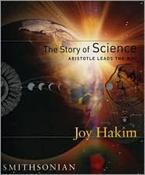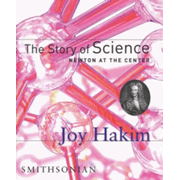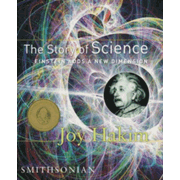Joy Hakim's delightful storytelling skills are brought to bear on science just as she did with her history series, The Story of US. Classical education fans, especially, should love her historical, biographical approach that brings science concepts to life as children explore the genesis of those ideas and the people who produced them. Likely because Hakim is not herself a scientist, she writes in a way that is very accessible for the non-scientist. While I would love to be able to give these books an unqualified recommendation, there are two significant problems: worldview issues and target audience. I'll address these later in this review.
There are three texts thus far in what the author tells us is projected to be a six-book series. All books are titled The Story of Science, but the three subtitles are Aristotle Leads the Way, Newton at the Center, and Einstein Adds a New Dimension. Physics and Chemistry get the most attention in these three texts, but the information presented is foundational for all study of science—students learn how to think scientifically. As I mentioned, Hakim is not a scientist, but it is clear that she has researched and drawn on the expertise of well-respected scientists for her content.
Books are hardcover and printed in full color. The first two volumes have companion student workbooks and teacher's guides called "Student's Quest Guides" and "Teacher's Quest Guides" respectively. The texts could be used independent of the workbooks and teacher's guides, but complete courses really require all three components.
Student workbooks include summary lists of "who," "what," "where," and "when" items covered in each chapter. This is followed by a number of activity sheets that vary from lesson to lesson. Some lessons include experiments while others might be completing charts from information in the text, working with math applications, or responding to text information in some other way. Experiments are much more extensive and challenging in the Newton workbook than in the Aristotle workbook. Teacher's guides include instructions for lesson presentation, illustrations (intended to be copied onto transparencies for an overhead projector), assessments, and answer keys. Both student workbooks and teacher's guides are printed in three colors—black/white/blue. One minor issue with the textbooks might be a problem for some students. There are numerous sidebars, boxes, pictures, illustrations, and other items that break up the text—so much so that it might be distracting and annoying.
Aristotle Leads the Way begins with what Hakim describes as creation myths that grew from early cultures' attempts to answer big questions such as "What is this universe of ours all about?", "What is life?", and "Is there anything that ties us to the stars and to all of creations?" Religion is treated as something with no rational basis, but simultaneously as something that is "good for society." Consequently, all religions are presented on an equal basis. In chapter 22 of the Aristotle text as well as in the student workbook, Hakim quotes selectively from St. Augustine of Hippo to promote the idea that (as she sums it up), "...there is no need for Christians to concern themselves with the details of scientific inquiry—as the Greeks did. All that is needed is an understanding that God created all things" (p. 196). Hakim revisits the relationship between religion and science in Newton, often raising excellent questions but sometimes revealing a shallow grasp of that relationship.
Following this, a lesson on calendars introduces the lunar cycle. Next, we encounter the early Greeks and the beginnings of geometry and hyptheses about the basic elements of life. The book continues in this fashion to show how scientific ways of thinking arose. There's a lot of history and biography! Astronomy, mathematics, and physics play the biggest role in these early years where science was more mental contemplation and calculation than experimentation.
The texts and workbooks gradually get more challenging in content as well as in size. Aristotle has 282 pages while, Newton and Einstein have 463 and 468 pages, respectively. However, no grade level recommendations are made anywhere that I can find, and there are peculiar inconsistencies in the content in regard to target audience. In Aristotle Leads the Way, sometimes, it seems like Hakim is writing to fifth and sixth graders while other times to high school students. Mathematical applications and explanations show up from time to time, and these seem to target an audience at least junior high and up. Activity sheets in Aristotle Leads the Way direct students to identify key points in the cosmologies of Pythagorus, Aristotle, and Aristarchus, then to identify points of conflict between the latter two cosmologies. Younger students might find this quite challenging. Yet, the large font, parenthetical explanations[e.g., the word "colossal" has "(huge)" next to it (p. 167)], and amount of content do not reflect a complete high school level course.
In Newton and Einstein, the content is obviously more extensive since both books are almost twice the size of Aristotle. But the science is still couched within the stories, so these books do not read like science texts nor do they cover equivalent amounts of science information. Nevertheless, Hakim's presentation might be a more effective method for teaching science because it is presented in way that students can really grasp and remember the concepts as well as their practical applications. Newton and Einstein together might cover science content fairly equivalent to another year-long physics course. (Students get lots of history along with the science so maybe these texts could used as part of a unit study approach.) Lab activities in the Newton student workbook are excellent and would at least partially satisfy a lab class requirement. I expect that when the Einstein student workbook comes out, it will fill the gap. These two texts really seem to be for high school level, although the student workbook activities mix challenging experiments with sometimes rudimentary reading comprehension questions.
The student workbook activities and experiments assume a classroom environment, often directing students to work in teams. It should be easy enough for homeschoolers to adapt most activities for their own situations.
The teacher's guides lay out step-by-step lesson plans, although they assume a classroom setting. Teachers should be showing the illustrations as they teach, directing students to read from the text, stimulating discussion, guiding students as they complete experiments or complete activity sheets. One technique used throughout both Aristotle and Newton, in both the workbooks and teacher's guides, is "scientists speak": A drawing of the philospher/scientist with a blank, cartoon "speech bubble" is shown on the overhead (or simply on a copy the student can see). Students are to determine the person's most important idea and "put words in his mouth." Student workbooks also have a cartoon for every lesson, used as a wrap up as students discuss how the cartoon connects to the main idea of the lesson.
Teacher's guides include three or four different assessments for each unit. One looks like a standard test. The other forms of assessment might be things like "Compose and perform a science story rap," "Practice using a Venn diagram to organize and write an essay that compares or contrasts two stories of creation," and "Create a scrapbook to illustrate how discoveries about electricity and magnetism have affected our modern lives." You might use one or more forms of assessment.
Overall, this is a very creative and engaging way to teach science. I have frequently expressed my opinion that we should be teaching children the history of science in exactly this way if we hope to engage their attention. So I love the concept, and I appreciate the creativity in the lesson plans and activities balanced with serious science content. I just wish that the target audience was more clearly identified and addressed, and that religious/worldview ideas were treated in what I would consider a more accurate manner.












